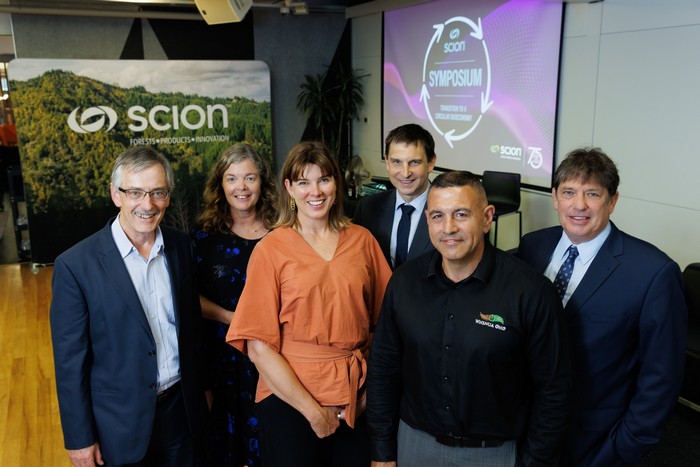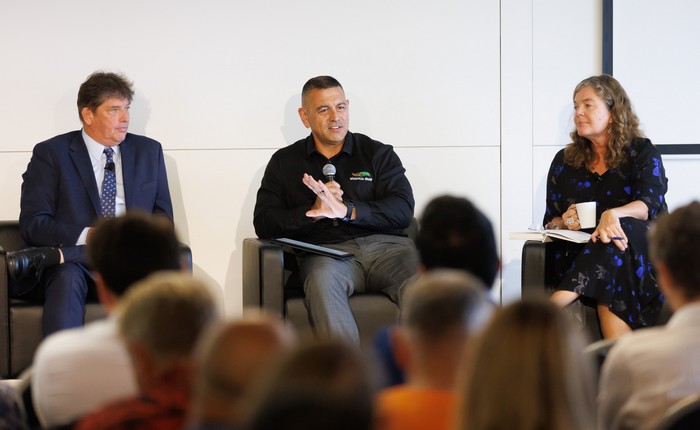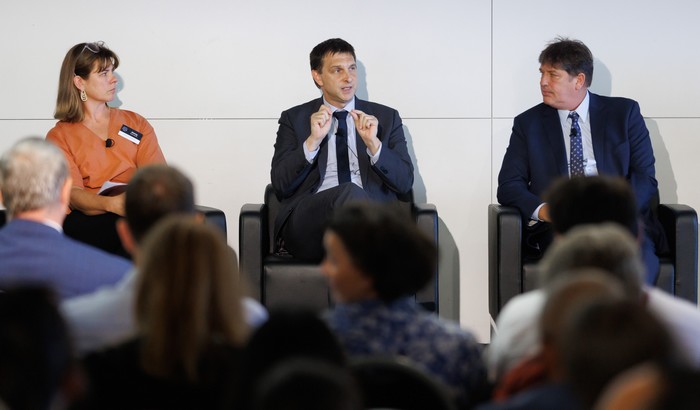Driving the circular bioeconomy forward
For immediate release
1 March 2023
Education, advocacy and courage will be needed to challenge and replace linear economic models that are currently hindering New Zealand’s progress on climate change action.
How New Zealand can take advantage of the opportunities to transition to a circular bioeconomy was explored at the Scion Bioeconomy Symposium in Wellington in February, held as part of events to commemorate Scion’s 75th Anniversary.
Scion hosted the event at the Wharewaka Function Centre to provide networking opportunities and spark conversations about the circular bioeconomy as momentum builds nationally and globally for ways to mitigate the effects of climate change and reduce the dependence that many countries have on fossil fuels.
Forestry is already recognised as a vital means of tackling climate change, and with Scion’s focus on research for the forestry and biobased sectors, the Crown Research Institute has become a leading voice in the circular bioeconomy approach. This is a model that addresses social, environmental and economic sustainability at the same time while operating within our planet’s boundaries. This has implications on several levels – in the case of waste, for example, waste from one process becomes feedstock for another. The concept aims to design out waste, keep materials in use for longer, and regenerate ecosystems.

Business commentator Rod Oram facilitated the symposium’s discussion involving five expert panellists: Prime Minister's Chief Science Advisor Dame Juliet Gerrard, Oji Fibre Solutions CEO and Scion board member Dr Jon Ryder, Whenua Oho CEO Te Kapunga Dewes, He Pou a Rangi Climate Change Commission Chair Dr Rod Carr, Fit for a Better World Chief Transformation Officer at MPI Jenny Cameron, and Scion General Manager for Forests to Biobased Products Dr Florian Graichen.
In exploring how New Zealand can accelerate the transition to a circular bioeconomy, Gerrard says making the economy more circular could become a ‘tier one’ national research priority. “There are obvious opportunities already in forestry and agriculture, but circular principles could be applied to any sector and industry in New Zealand.”
Panellists also pointed out it is important to consider how the circular model could serve New Zealand as both an export nation and the needs of Kiwis whose current domestic priorities are more focussed on the cost of living and food security. Gerrard stressed that bioeconomy messaging needs to be simple and relatable, citing waste reduction as a tangible action that people can support. “How big do our circles need to be, and how can the circular bioeconomy best serve everyone?”
Four pillars
Carr noted that the transition would need to solve four critical pillars to be successful: energy, mobility, the built environment and agriculture. With 60 percent of New Zealand’s energy sourced from fossil fuels, energy needs to be addressed first.
“In our built environments, if we haven’t reduced the amount of travel required to get from work to home and home to where we learn by 2050, then we won’t get anywhere closer to where we need to be in a circular economy. But we need to solve all four pillars, or we will only have a circular economy with a big hole in it.”
Progress, however, is being made, and central government has launched plans that serve as a catalyst for transformation across multiple sectors, including primary industries.
The Fit for a Better World roadmap lays out the Government’s plan for rebuilding a better economy, spanning all the food and fibre sectors, including agriculture and horticulture. Last November Minister of Forestry Stuart Nash unveiled the Forestry and Wood Processing Industry Transformation Plan (ITP) at Fieldays. Increasing New Zealand’s onshore wood processing capability and investment in transforming and developing our domestic woody biomass industry are two target areas identified in the ITP that will drive sector growth, create jobs, and reduce emissions across the economy.
Cameron pointed out that while central government can influence the pace of New Zealand’s transition to a circular bioeconomy, communities and sectors could adopt more circular practices without waiting for regulation first.
AgriSea and Ecogas are shining examples of New Zealand companies that have embraced research and technology as they’ve looked to repurpose and turn waste into a resource, she said.
“We need to get behind these exemplars so we can show other businesses what’s possible and how it can be achieved.”

Learning from past mistakes
Dewes highlighted how principles of the circular bioeconomy are already embedded in Te Ao Māori, which takes an intergenerational view to caring for whenua and people, as guided by the principle of kaitiakitanga (guardianship and protection of the environment).
However, he reminded participants that in creating a national circular bioeconomy strategy for New Zealand, how the priorities are set are just as important as what they are.
“The way we’ve done things in the past haven’t worked and history shows us we lurch from one priority to the next. If we took a more intergenerational approach and ensure all aspects of society are given a voice, we’d be better off.
“But do we have the political and social will to make that happen? Our current structures don’t support this.”
Graichen agrees that existing mindsets and systems that accelerated the linear economy are no longer fit for purpose in a world feeling the effects of a climate crisis.
“On top of that we have a world that is moving towards a population of 10 billion people – 10 billion people that require food, clothing, housing or transport. We must rethink on a systems level which includes the need to source materials from sustainable – not fossil – feedstock.
“We need to look through a different lens and for us at Scion, we look at all the benefits to a society that come from a circular bioeconomy - more sustainable environment and better community wellbeing. Not all the drivers are simply economic.
“But we need speed and urgency around our national bioeconomy strategy. We are talking about unlocking a generational and transformational opportunity for the country through mitigating climate change and creating prosperity.”

The global landscape
Earlier, Chair and Founder of the World Bioeconomy Forum Jukka Kantola delivered a pre-recorded message from Finland to congratulate Scion on celebrating its 75th anniversary and success at driving innovation and growth from forestry and wood-derived materials.
Nearly 60 countries have national bioeconomy strategies, and more are expected to be unveiled this year. It’s believed bioeconomies contribute as much as US $30 trillion to the global economy each year.
“There is a bio-revolution emerging as part of the fourth industrial revolution and this is providing us with new tools to tackle our global challenges and reduce dependence on fossil fuels,” Kantola says.
Nash, speaking in his capacity as Minister for Economic Development, also confirmed that the Government had started work on its circular and bioeconomy strategy to help New Zealand move from an extractive economic model to one that is regenerative, has low emissions and is inclusive.
Scion was privileged to have Nevin Broughton from the local Iwi Te Ati Awa open the symposium acknowledging the whare of Wharewaka and the tributaries around the event. He also offered a “wero” or challenge to participants to learn from traditional Māori knowledge as they worked through the symposium’s key issues.
ENDS
